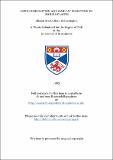Lipid composition and habitat selection in higher plants
Date
1983Metadata
Show full item recordAbstract
Lipid analyses of the leaves of Empetrum nigrum subspp. hermaphroditum with an upland distribution in the U.K. and the lowland E. nigrum subspp. nigrum revealed a) that the lowland subspecies had higher total and neutral lipid levels throughout 1979 b) that total lipid levels remained constant within the leaves of both subspecies throughout the year. c) that storage lipid (triacylglycerols) contributed 1.4% and 4.5% to the total lipid of subspecies hermaphroditum and nigrum respectively. This data is inconsistent with the suggestion that the high leaf total lipid levels associated with alpine species represent high levels of storage lipid. Instead it is suggested that the high lipid content of Empetrum leaves may be a reflection of a well-developed waxy cuticle. It'is pseudacorus occupies habitats characterized by poor O2 availability and is able to tolerate up to two months total anoxia without any loss in viability. By contrast the cultivated Iris qerrnanica var Quechei typically a plant of well drained soils suffers 100% mortality during 8 weeks anoxia. Further the cut primary shoot of I. germanica was observed to be more susceptible to anoxic injury than the I. remainder of the rhizome. As the biosynthesis of polyunsaturated fatty acids requires the participation of molecular oxygen it was thought profitable to compare what changes occurred in the anoxia tolerant I. pseudacorus and intolerant I. germanica when subject to anoxic stress. In I. pseudocorus there were a number of lipid modification during anoxia. Glycolipids declined dramatically and although all fatty acids declined it was surprising that saturated acids decreased the most. It was suggested that the decline in glycolipids might reflect mobilization of carbohydrate reserves and/or a replenishment of the fatty acid pool through glycolipid breakdown. The significance of the alterations in membrane fluidity which might be expected to result from alterations in the saturated /unsaturated ratio remain unexplained. By complete contrast, the anoxia intolerant I. germanica although possessing a highly similar lipid profile exhibited no changes in lipid composition in response to anoxia. Therefore membrane dysfunction through lipid component omission is not a major factor in anoxic mortality. Through production of cytotoxic species such as H2O2, O2, OH and 1O2, O2 may bring about peroxidative damage. On rexposure to air it was found that the highly anoxia sensitive primary shoot tissue of I. germanica produced 38 times more malondialdehyde (M.D.A. - a lipid peroxidation product) than material which was maintained aerobically. 1. pseudacorus did not exhibit such differences. Although the overall levels of M.D.A. are higher in I. pseudacorus it may be that the primary shoot tissue contains efficient endogenous secondary protection mechanisms to make good peroxidative damage. However, in the natural environment it is unlikely that the species would ever be exposed to such rapid alterations in O2 concentrations.
Type
Thesis, PhD Doctor of Philosophy
Collections
Items in the St Andrews Research Repository are protected by copyright, with all rights reserved, unless otherwise indicated.

